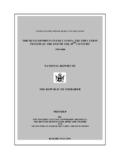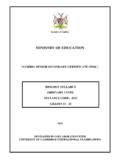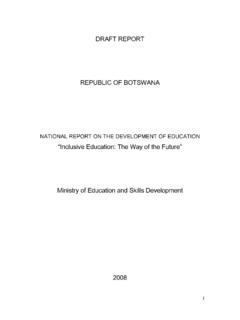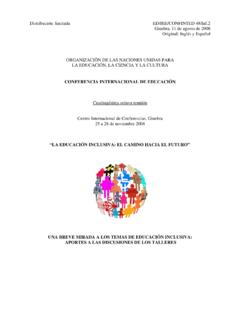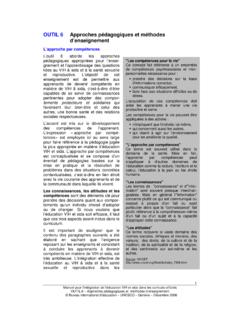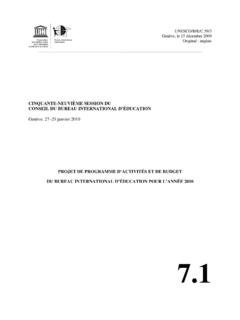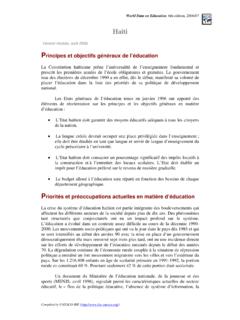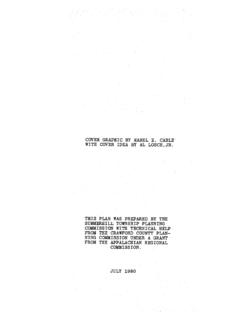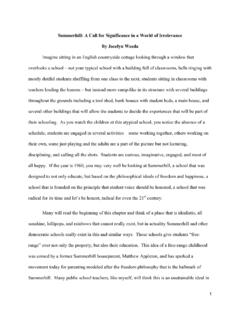Transcription of Alexander Sutherland Neill - ibe.unesco.org
1 1 The following text was originally published in Prospects:the quarterly review of comparative education (Paris,UNESCO: International Bureau of Education), vol. XXIV, no. 1/2, 1994, p. 217 229. UNESCO:International Bureau of Education, 2000 This document may be reproduced free of charge as long as acknowledgement is made of the Sutherland Neill (1883 1973)Jean-Fran ois Saffange1 The death of Neill on 23 September 1973 went almost unrecorded in the newspapers, yet itmarked the end of the saga of summerhill , his little school in Suffolk, England, and set the seal onthe disregard or even rejection of a man who had come to symbolize a decade of radical approach to child rearing (1960)
2 , a best-seller in the 1960s, had madeSummerhill a centre of avant-garde libertarian education and placed Neill at the very heart of aheated educational controversy. Even when the most indignant protests and accusations of childcorruption were being voiced, pupils and visitors flocked to this somewhat disturbing enthusiasm met with success, although oddly enough it failed tomake Neill famous. Little is generally known of the daily life of the school or of the fact thatSummerhill is above all the story of an educator s long-lasting dream, a dream made of generosity,vulnerability and naivety, a dream with which all those involved in education can pioneer of the 1920sWhen he was discovered in the 1960s, Neill was very soon classed as a disciple of Reich.
3 The twomen were indeed very close, but it should not be forgotten that the work of Neill must first be seenin terms of exceptional educational longevity. When he died at the age of 90, Neill had spent mostof his life in the classroom: as pupil, as pupil-teacher with his father, as teacher and then asheadmaster. Any influences that exist thus go back much earlier in the century. Neill was hardlyrecognized for what he was, that is, above all the last survivor of the New Education movementthat flourished at the turn of the century.
4 Time in any case had already taken its toll of theseadventurous years of education, leaving a trace only of the leading figures and passing over theextraordinary proliferation of research discoveries and idealistic theories. From this point of view,the English-speaking branch, where Neill had found his own special place, was by no means theleast is not generally known that in 1920 he ran the review New Era with the theosophistBeatrice Ensor, thus becoming a close observer of a wide variety of experiments and achievementsand promoting the spread of new ideas, not hesitating to act as an ardent and more than partialpropagandist.
5 In those years, Neill was already, in the words of Adolphe Ferri re, the enfantterrible of extremist educational ideas in England (Ferri re, 1922, p. 384). A reader of Freud,whose ideas he used skillfully to deride his colleagues, a fierce adversary of Maria Montessori,already an eminent educational theorist, whom he accused of having an over-scientific andmoralistic approach, Neill sowed the seeds of controversy and provoked much indignation andcourage (Hemmings, 1972, p. 57), until his ultimate exclusion from the review.
6 Nor is it widelyknown that he attended the Calais Congress, where he met Decroly, Ferri re and all the leadingpioneers, leaving his mark as the author of avant-garde became better known after the First World War through the success of his first book Adominie s log (1915); but above all he liked to think of himself as the spiritual son of Homer Lane,another figure of the English movement, the founder of the Little Commonwealth, an establishmentof young delinquents run on the principle of self-government. Homer Lane, of American origin, hadlearned to be an educator in the United States at the George Junior Republic.
7 Attacked for hispractices, Lane put up a clumsy defence and was forced to leave England. Neill saw in him his firstmartyr. Reich was to be the opened his first school in 1922 during a journey through Europe, but he founded summerhill ,near Leiston, in England, in 1924. The little school existed for decades without a change. Throughsome twenty books and countless articles, he related the daily life of the school, never missing anopportunity to provoke argument, repeatedly describing a place in which the adult had not imposedhis will, a place for play where total disorder great deal of the damage done to the school was done by the children.
8 The wear andtear of materials in summerhill is a natural if a boy needs a piece of metal for a boatkeel, he will use my expensive tools if one of them happens to be about the right size (1970, p. 13,34, 130).* Journalists called summerhill the do-as-you-please-school (Hemmings, 1972, p. 140).Many of the visitors indeed saw the school as a Kafkaesque universe with dilapidated andsometimes vandalized buildings .(Vallotton, 1967, p. 9). Yet the school, with its wooden buildings,its large park and trees, seemed, especially in summer, one of the most pleasant of places, a realcountry school such as Ferri re dreamed of at the beginning of the this school, however, lessons were optional.
9 The children could play all day if they sowished, or do handicrafts in the workshop. The evenings were set aside for dancing, theatre andentertainment. If it had not been for the threat of the school being closed by the authorities, Neillwould have placed no ban on sexual evening was set aside for the general assembly. During that meeting, which waschaired by an elected pupil, the children explained their problems and discussed them, working outtheir own rules. In this assembly, Neill s vote, like that of the other adults, had no greater weightthan that of a pupil.
10 This, says Neill , was the secret of the success of an educational technique learntthrough contact with Homer originality, the provocation and success of the founder s books were not alwayssufficient to protect the school from the risk of closure. After the Second World War, there was adangerous decrease in the number of pupils and the summerhill Society had to be founded in orderto save the school. The education authorities never really accepted it. When they went back on theirdecision to close the school, some, as Hemmings (1972, p.)
